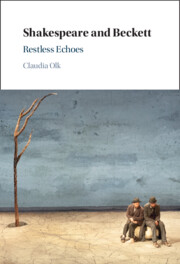Book contents
- Shakespeare and Beckett
- Shakespeare and Beckett
- Copyright page
- Contents
- Acknowledgements
- Abbreviations
- Introduction
- Chapter 1 Shakespeare and Beckett on the Edges
- Chapter 2 Molecular Shakespeare – Beckett Reading Shakespeare through Joyce
- Chapter 3 ‘Some remains’: Beckettian and Shakespearean Echoes
- Chapter 4 Purgatory and Pause – Shakespeare, Dante and the Lobster
- Chapter 5 ‘[It is] winter/Without journey’ – Still Lifes in Beckett and Shakespeare
- Chapter 6 Endgames
- Chapter 7 Theatres of Sleep
- Conclusion
- Bibliography
- Index
Chapter 2 - Molecular Shakespeare – Beckett Reading Shakespeare through Joyce
The poetics of the hieroglyph and ‘the insurrection of molecules’
Published online by Cambridge University Press: 19 January 2023
- Shakespeare and Beckett
- Shakespeare and Beckett
- Copyright page
- Contents
- Acknowledgements
- Abbreviations
- Introduction
- Chapter 1 Shakespeare and Beckett on the Edges
- Chapter 2 Molecular Shakespeare – Beckett Reading Shakespeare through Joyce
- Chapter 3 ‘Some remains’: Beckettian and Shakespearean Echoes
- Chapter 4 Purgatory and Pause – Shakespeare, Dante and the Lobster
- Chapter 5 ‘[It is] winter/Without journey’ – Still Lifes in Beckett and Shakespeare
- Chapter 6 Endgames
- Chapter 7 Theatres of Sleep
- Conclusion
- Bibliography
- Index
Summary
This chapter discusses how literary heritage and authorial legacies are addressed, reflected on and performed in reconfigurations of Shakespeare. It reads the encounter of Beckett’s aesthetics with Shakespeare by way of Joyce’s use of language and his performative reworking of literary heritage. Interacting with Joyce, Beckett also found an early model of how to engage with literary history in a way that is both creative and destructive. The chapter focuses on the ‘Scylla and Charybdis’ episode of Ulysses, which inquires into notions of authorship, national heritage and identity. With regard to Shakespeare, and particularly Hamlet, the chapter records various received paradigms of literary lineage and reception. The second part of this chapter traces Beckett’s inversions of Joycean and Shakespearean paradigms. Shakespeare becomes part of the creative matrix of Beckett’s works where the very richness of his material emerges in his use of minute details and his attention to the mole-cular level of languages and ideas that form the minimal components of his work.
- Type
- Chapter
- Information
- Shakespeare and Beckett , pp. 38 - 72Publisher: Cambridge University PressPrint publication year: 2023

